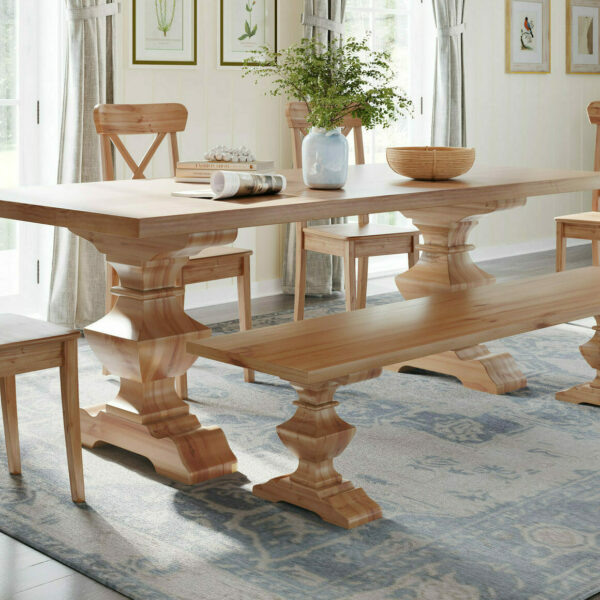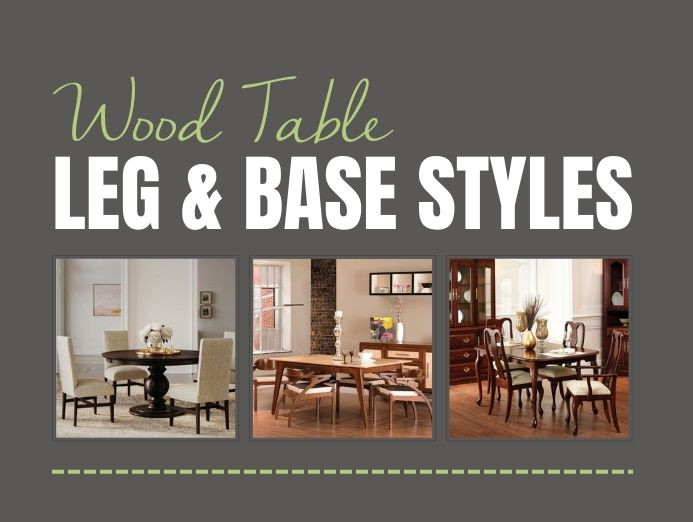How to Select the Perfect Eating Room Table Legs for Your Home Decor
Selecting the perfect dining-room table legs is a nuanced procedure that requires mindful consideration of different aspects, including your space constraints, visual choices, and sensible demands. The interaction in between products, styles, and dimensions can substantially affect the ambiance of your eating area, making it important to approach this choice carefully. As you ponder the myriad alternatives readily available, it becomes clear that the right choice extends past plain appearance; it can enhance your overall dining experience. What aspects should you prioritize to ensure your selection enhances your home's special character?
Assess Your Eating Room
Examining your eating space is important for choosing the right table legs that enhance both aesthetic appeals and performance. Begin by gauging the dimensions of your eating area, consisting of ceiling height, floor space, and closeness to other furniture. This information will help identify the proper size and height of your table, which straight affects the choice of table legs.
Following, consider the style and layout of your eating space. For circumstances, an open-concept layout may profit from table legs that use aesthetic agility, such as slim steel or acrylic alternatives. On the other hand, an extra conventional setup might call for tough wooden legs that supply a sense of durability.
Evaluate the existing shade scheme and materials in your dining location. Integrating the table legs with these elements produces a cohesive appearance that improves the total decor. Furthermore, consider the performance required in your area. If you frequently host large gatherings, take into consideration legs that offer extra assistance and security.
Ultimately, a detailed assessment of your eating space will guide you in making an educated decision, making certain that your table legs not only boost the visual allure however also offer useful objectives.
Consider Your Style Preferences
When selecting dining-room table legs, it is important to reflect on your individual style choices, as they significantly influence the overall visual of your eating room. Your choice of table legs can either complement or contrast with existing decoration, making it crucial to straighten them with your recommended interior layout motif.
If your home leans towards a contemporary visual, take into consideration smooth metal or minimal wooden legs that provide a clean, minimalist look. For a more standard strategy, ornate wood legs with elaborate makings can add a touch of beauty and refinement. Industrial styles take advantage of durable, basic materials such as recovered timber and steel mixes, mirroring a sturdy beauty.
Additionally, farmhouse and rustic styles commonly prefer sturdy, beefy legs that evoke a sense of heat and convenience. On the other hand, if your decoration is eclectic, you might choose non-traditional shapes or a mix of materials to produce aesthetic passion.

Evaluate Material Options
The option of product for eating space table legs plays a crucial duty in both durability and aesthetic charm. Usual products consist of wood, metal, and composite options, each offering distinct qualities that can influence the overall look and long life of your table.
Timber is a timeless selection, recognized for its heat and flexibility. Hardwoods like oak and walnut offer phenomenal toughness and can be completed in various stains to match any decor. Softwoods like want are a lot more susceptible to dents and scratches, making them much he has a good point less optimal for high-traffic locations.
Steel legs, commonly crafted from steel or light weight aluminum, radiate modernity and industrial beauty. They are immune and highly long lasting to wear, making them ideal for households with children or constant gatherings (dining room table legs). In addition, steel can be completed in various shades, improving the modification possibilities
Composite products, such as MDF or laminate, offer affordability and diverse layouts. While usually less long lasting than strong wood or metal, they can still supply a trendy appearance and are usually easy to keep.
Eventually, the material you pick ought to align with your way of life, visual preferences, and the level of usage your table will certainly experience.
Determine Height and Size
Picking the appropriate height and dimension for your eating room table is crucial for both performance and convenience. The standard height for dining tables typically ranges from 28 to 30 inches, enabling ample legroom for a lot of individuals when seated. Nevertheless, it is vital to think about the dimensions of your dining area and the sorts of chairs you plan to utilize.

Moreover, consider the proportions of your dining-room. A larger table in a sizable location can create a grand atmosphere, while a smaller sized table works well in more intimate settings. Inevitably, the appropriate height and dimension will integrate with your general design and enhance the eating experience for you and your visitors.
Explore Customization Opportunities

Additionally, the design of the legs can be customized to fit numerous designs, such as rustic, contemporary, or industrial. For instance, conical legs can evoke a mid-century modern feeling, while beefy, block-style legs may reverberate with standard or farmhouse design.
House owners can also check out shade surfaces, from all-natural wood stains to repaint, allowing them to match or comparison with the tabletop and bordering decor.
In addition, leg elevation can be adjusted to suit certain seating plans or personal choices, enhancing both convenience and functionality.
Lastly, special decorations, such look at here as carvings or attractive brackets, can further customize the table legs, making the eating experience not just a dish but a declaration piece in the home. By considering these modification options, house owners can develop an eating area table that absolutely mirrors their originality.
Conclusion
Choosing the suitable dining room table legs needs careful factor to consider of various elements, including the dimensions of the dining space, design preferences, material toughness, and preferred elevation. Personalization alternatives additionally boost the ability to attain a natural aesthetic that enhances the general decor. By methodically reviewing these aspects, homeowners can ensure that the chosen table legs not just fulfill practical demands yet additionally add favorably to the eating Our site experience and setting of the home.
Selecting the suitable eating space table legs is a nuanced procedure that calls for mindful consideration of various elements, including your space constraints, aesthetic preferences, and sensible demands.Analyzing your dining space is important for choosing the right table legs that match both aesthetics and functionality.When identifying dimension, determine the area where the table will be placed to guarantee it fits pleasantly, allowing for at least 36 inches of clearance around the table for easy movement. A larger table in a large area can produce a grand atmosphere, while a smaller sized table works well in more intimate setups.Picking the perfect dining room table legs calls for mindful consideration of numerous aspects, including the measurements of the eating space, design preferences, material durability, and wanted height.
 Angus T. Jones Then & Now!
Angus T. Jones Then & Now! Brandy Then & Now!
Brandy Then & Now! Hailie Jade Scott Mathers Then & Now!
Hailie Jade Scott Mathers Then & Now! Robbie Rist Then & Now!
Robbie Rist Then & Now! Shannon Elizabeth Then & Now!
Shannon Elizabeth Then & Now!